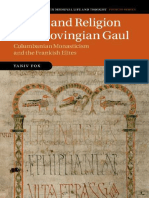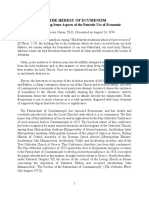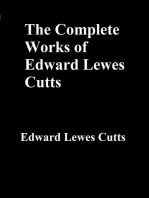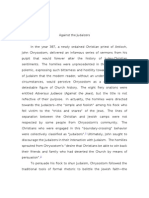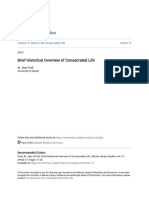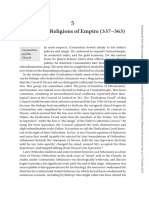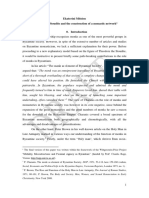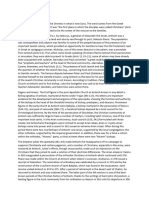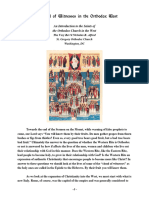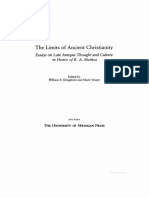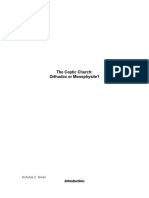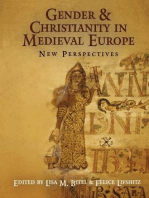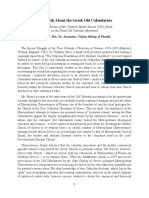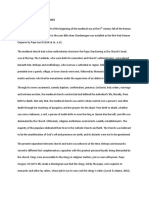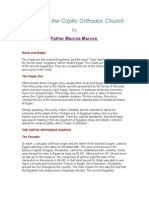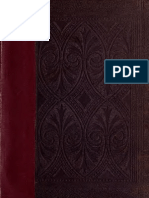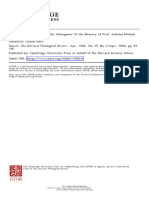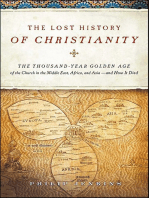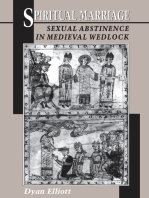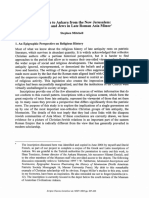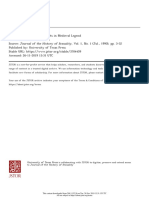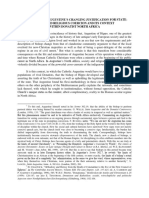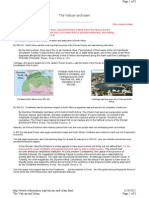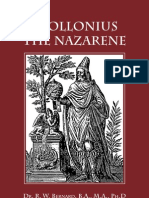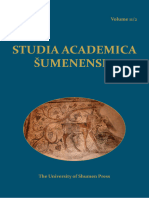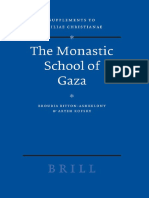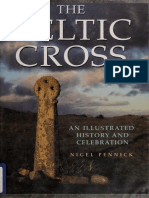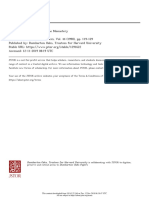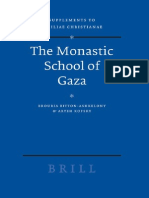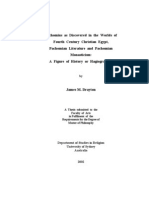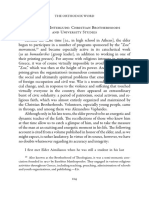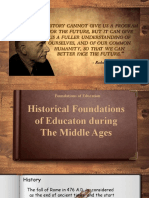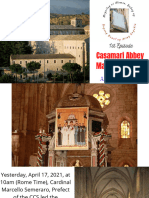This Content Downloaded From 80.96.21.180 On Wed, 11 May 2022 12:17:51 UTC
This Content Downloaded From 80.96.21.180 On Wed, 11 May 2022 12:17:51 UTC
Uploaded by
Тату Георгий ЮлианCopyright:
Available Formats
This Content Downloaded From 80.96.21.180 On Wed, 11 May 2022 12:17:51 UTC
This Content Downloaded From 80.96.21.180 On Wed, 11 May 2022 12:17:51 UTC
Uploaded by
Тату Георгий ЮлианOriginal Description:
Original Title
Copyright
Available Formats
Share this document
Did you find this document useful?
Is this content inappropriate?
Copyright:
Available Formats
This Content Downloaded From 80.96.21.180 On Wed, 11 May 2022 12:17:51 UTC
This Content Downloaded From 80.96.21.180 On Wed, 11 May 2022 12:17:51 UTC
Uploaded by
Тату Георгий ЮлианCopyright:
Available Formats
Late Roman and Byzantine Legislation on the Monastic Life from the Fourth to the
Eighth Centuries
Author(s): Charles A. Frazee
Source: Church History , Sep., 1982, Vol. 51, No. 3 (Sep., 1982), pp. 263-279
Published by: Cambridge University Press on behalf of the American Society of Church
History
Stable URL: https://www.jstor.org/stable/3167117
REFERENCES
Linked references are available on JSTOR for this article:
https://www.jstor.org/stable/3167117?seq=1&cid=pdf-
reference#references_tab_contents
You may need to log in to JSTOR to access the linked references.
JSTOR is a not-for-profit service that helps scholars, researchers, and students discover, use, and build upon a wide
range of content in a trusted digital archive. We use information technology and tools to increase productivity and
facilitate new forms of scholarship. For more information about JSTOR, please contact support@jstor.org.
Your use of the JSTOR archive indicates your acceptance of the Terms & Conditions of Use, available at
https://about.jstor.org/terms
and Cambridge University Press are collaborating with JSTOR to digitize, preserve and extend
access to Church History
This content downloaded from
80.96.21.180 on Wed, 11 May 2022 12:17:51 UTC
All use subject to https://about.jstor.org/terms
Late Roman and Byzantine Legislation
on the Monastic Life from the Fourth to
the Eighth Centuries
CHARLES A. FRAZEE
Christian monasticism in the East has three sources: the original rule o
founder or that of a reformer, laws issued by the Roman emperors, and
canons of church councils. The purpose of this article is to study the
two, which have received little attention in the scholarly work on m
life. The close association between church and state, unique to the East, m
it incumbent upon the leaders of both the secular and religious hierarch
Byzantium to oversee the development of monasticism from the fourth
eighth century. Those 400 years mark the first and normative per
legislation dealing with the monastic life.
Monasticism, which began in Egypt with Saint Antony, soon sprea
Palestine, Syria, Anatolia, and beyond. Once it had attained such p
tions, the movement attracted the attention of Christian bishops,
recognized it as something requiring their surveillance. The bishops rega
monasticism with reserve, since it had originated outside of the sta
Christian institutions. Ascetics had been known in the church from apos
times, and a promise of celibacy made before a bishop was comm
accepted for both men and women. It was obvious that the early monks
nuns were often simple peasants with little education or culture, a point
monastic critics were quick to make. The clergy could not help bu
skeptical about the future of a movement which was largely self-directe
so popular as to threaten their own functions.1
Monks and nuns soon proved themselves to be favorites of the pe
closely allied to them in affliction and suffering. For the Christian layp
seeking spiritual direction, the monastery was a magnet. The lean ascetic
stood in marked contrast to the lives of the sophisticated urbanized episc
1. Libanius of Antioch, "Oration Two," in Selected Works, Loeb Classical Library
bridge, 1977), pp. 26-28. Other monastic critics are mentioned in Augustin Flich
Victor Martin, eds., The History of the Church, trans. E. Messenger (New York,
vol. 4, The Christian Church in the Roman Empire, ed. Jean Remy Palanque et al
pp. 491-494. Legislation on ascetics was enacted at the local councils of Elvira, Ancyr
Gangra. See Johannes Mansi, Sacrorum conciliorum nova et amplissima collectio, rev
54 vols. (Graz, 1960), 2:2-5, 513-521, 1095-1100.
Mr. Frazee is professor of history in California State University, Full
California.
263
This content downloaded from
80.96.21.180 on Wed, 11 May 2022 12:17:51 UTC
All use subject to https://about.jstor.org/terms
264 CHURCH HISTORY
and clergy. The classic tension between priest and pr
Christian history.
Constantine, the first emperor of the fourth century to
the church, was also the first emperor to welcome in
Christian ascetic, Paphnutius. The emperor recognized
man with extraordinary powers. Later, when the empe
Antony's foundation in the Egyptian desert, he wrot
support.2
In contrast to the usual bishops' reaction toward the monks, Athanasius,
the powerful patriarch of Alexandria, wisely decided to draw the monks of
Egypt to his side during the struggle against the Arians. Afterwards, the
patriarchs of Alexandria would always be regarded as patrons of monks
everywhere. Athanasius's contribution to monasticism did not stop with his
ensuring doctrinal orthodoxy; he first brought Egyptian monks to the West,
and it was his name that became attached to the extremely popular biography
of Saint Antony. The orthodox could not have won their victory over
Arianism without the persistence of Athanasius's supporters that continued
long after the patriarch's death.
The emperor Valens, who came to office in 364 as a strong proponent of
Arianism, was well aware of the strength within the ranks of the monks and
knew that an attack upon monastic foundations would strike a blow for
Arianism. In 370 he issued the first imperial measure dealing with monks. In
this edict Valens claimed that "certain devotees of idleness" had gone out into
the desert to join bands of hermit monks in order to avoid the compulsory
service they owed to their cities. There was some justification for his
complaint. John Cassian, one of monasticism's most important figures,
admitted that a number of solitaries were frauds living without direction and
avoiding all responsibility.3
Valens specifically ordered the Count of the East, stationed in Antioch, to
ferret out the delinquents and to bring them back into the cities to meet their
obligations; those who would not comply were to be stripped of all their
possessions. According to Saint Jerome, overzealous soldiers ransacked the
caves of the monks of Nitria and killed many of the monks.4 Many were
rounded up and deported to the quarries and mines of Pontus and Armenia.
A monk named Piamun, who had been sent on an errand of mercy to his
2. Sozomen, History of the Church 1. 13. 1 (Bidez and Hansen, p. 27); Socrates, History of the
Church 1. 11 (Migne, PG 67. 101-102).
3. Valentinian and Valens to Modestus, Praetorian Prefect, 1 January 370, in The Theodosian
Code and Novels and the Sirmondian Constitution, ed. Clyde Pfarr (Princeton, 1952),
p. 351; Cassian, Collationes 18, ed. E. Pichery, Sources chretiennes 64 (Paris, 1959),
pp. 18-19.
4. Jerome, Chronicle, twelfth year of Valens, in Eusebius, Eusebius Werke, ed. Rudolf Helm
(Berlin, 1956), vol. 7, Die Chronik des Hieronymus, p. 248; Socrates, History 4. 24 (Migne,
PC 67. 521-523).
This content downloaded from
80.96.21.180 on Wed, 11 May 2022 12:17:51 UTC
All use subject to https://about.jstor.org/terms
LEGISLATION ON MONASTIC LIFE 265
fellows in Egypt, observed, "In some towns we could only
traces of those who were cenobites, and as for anchorites, w
word had become completely unknown."5
Saint Basil of Caesarea was a contemporary of Valens. U
monks of his day, Basil came from a family of aristoc
educated in the best schools of the empire. In imitation
Eustathios of Sebastea, Basil and his friend Gregory of N
brotherhoods and sisterhoods devoted to the ascetic life. Later when he was
elevated to the episcopate, he was able to demonstrate that a monk-bisho
could actually be a positive force within the church. His sermons, preached to
both men and women ascetics, provided a rule of life for his followers and,
subsequently, a rule for all Byzantine monks and nuns. He believed strongly
in the superiority of the cenobitic over the anchoritic life and in the
centralization of monastic authority in the abbot. He stressed the need for his
brotherhoods and sisterhoods to be self-sufficient and especially, through acts
of charity, to demonstrate the church's concern for the poor, sick, and aged.6
While Basil's ascetic communities were marked by moderation, the monks
and nuns of Syria and Egypt often were convinced that holiness required
pushing oneself to the limits of human endurance. They practiced fasts, vigils
and penitential disciplines of all kinds in an attempt to prove their devotion t
God and their contempt for worldly comforts. As long as these heroes of the
faith lived in remote and solitary places they did not cause much concern to
the civil and religious authorities. But, late in the fourth century, afte
Theodosius had made Christianity the official Roman religion, monasterie
and solitaries moved closer to the cities, where they exerted a powerfu
influence upon the urban populations. The people always were eager to se
sanctity in the eccentric and were willing to defend their holy heroes against
all "injustices," real or imagined, whenever threatened.
Despite his reverence for those who had dedicated their lives to God,
Theodosius was at last forced to take action. In a rescript of 2 September 390
the emperor ruled that henceforth monks must inhabit deserted places. They
were forbidden to come into cities or to live within their boundaries.7 Since
women's monasteries were neither so numerous nor so likely to engage in
political action, they were not mentioned in this edict. At the time of the edict
some Egyptian towns were full of monks: the small town of Antinoe hel
5. Cassian, Collationes 18 (Pichery, pp. 21-22).
6. See Ernest F. Morison, St. Basil and His Rule (Oxford, 1912); W. Lowther Clarke, The
Ascetic Works of St. Basil (London, 1925); Peter Nagel, Die Motivierung der Askese in der
alten Kirche und der Ursprung des Monchtums, Texte und Untersuchungen 45 (Berlin,
1966).
7. Valentinian, Theodosius, and Arcadius to Tatianus, Praetorian Prefect, Theodosian Code
16. 3. 1 (Pfarr, p. 449). See also Philip Rousseau, Ascetics, Authority, and the Church in the
Age of Jerome and Cassian (New York, 1978), for the growth of monastic influence in the
later fourth century.
This content downloaded from
80.96.21.180 on Wed, 11 May 2022 12:17:51 UTC
All use subject to https://about.jstor.org/terms
266 CHURCH HISTORY
twelve monasteries, and Oxyrynchos was described as having
monks and anchorites than of ordinary people.8 So powerful
influence on the emperor that in less than two years he resci
Justifying his change of mind, the emperor alleged that in
orders, too many civil and military officials had treated mo
had used the imperial prohibition as an opportunity to vent
upon the monks.9 After Theodosius's death, monastic influen
grew so intense that his sons, Arcadius and Honorius, r
bishop had a vacancy among his clergy, he should appoint so
a monk.10
On the other hand, civil officials of Syria and Egypt were constantly
complaining to the emperor about the difficulties they had in performing
their duties due to the intervention of monks in civil affairs. The special
reverence given to the monks by the populations of these regions allowed them
to project themselves into the judicial process with increasing frequency. At
this time, Simon Stylites, the most famous of the pillar monks, regarded it as
quite within his competence to adjudicate lawsuits, and imitators followed his
example.1 For these reasons the emperors ruled that it would no longer be
permitted for a cleric or monk to interfere in the courts. Once a penalty was
handed down by the imperial judges, it must stand, although a monk would
be permitted to appeal a sentence in the usual way to proper authorities. If
ascetics persisted in thwarting the judges, and in some places their interfer-
ence had caused riotous actions, the emperors ruled that they should be placed
under arrest. If the disturbances were really serious, the case should be
brought personally to the attention of the emperor. The same edict also
warned the bishops that they would be held accountable for any irresponsible
actions taken by monks within their dioceses.12 But the monks of Egypt were
not to be curtailed so easily. In the following years monastic mobs prevailed
against Patriarch Theophilus of Alexandria to condemn Origen. Later this
same patriarch used the monks, who were on his side in this affair, to destroy
the remaining pagan temples of the city. Hypatia, the philosopher-poetess of
Alexandria, also became a victim of monastic vengeance during the time of
Saint Cyril.'3
8. Cuthbert Butler, trans., The Lausiac History of Palladius (Hildesheim, 1967), pp. 419-420;
Andre-Jean Festugiere, ed., Historia monachorum in Acgypto, Subsidia hagiographica 53
(Brussels, 1971), pp. 41-42.
9. Edict of Theodosius I, 17 April 392, Theodosian Code 16. 3. 2 (Pfarr, p. 449).
10. Arcadius and Honorius to Caesarius, Praetorian Prefect, 26 July 398, Theodosian Code
16. 2. 32 (Pfarr, p. 446).
11. Evagrius, History of the Church 1. 13 (Bidez and Parmentier, pp. 21-23); Sozomen, History
6. 27. 10 (Bidez and Hansen, p. 276); W.H.C. Frend, "The Monks and the Survival of the
Eastern Roman Empire," Past and Present 54 (1972): 6-10.
12. Arcadius and Honorius to Eutychianus, Praetorian Prefect, 27 July 398, Theodosian Code
9. 40. 16 (Pfarr, p. 257).
13. Socrates, History 7. 14 and 15 (Migne, PC 67. 765-769).
This content downloaded from
80.96.21.180 on Wed, 11 May 2022 12:17:51 UTC
All use subject to https://about.jstor.org/terms
LEGISLATION ON MONASTIC LIFE 267
During the rule of Arcadius's son, Theodosius II, the mon
in the capital grew ever stronger. The spirituality of this
family was so influenced by the ascetics that "his palace w
monastery for he and his sisters rose in the morning and rec
hymns in praise of God."14 The long reign of the emperor w
by positive events, such as the codification of Roman law
unfortunate ones, such as the long drawn out controversy
patriarch Nestorius over the natures of Christ. Only
legislation from this period deals with monastic life. Th
disposition of the possessions of deceased monks and nuns. In
ruled that if the decedent had no blood relatives, the property
decedent's monastery, provided that the establishment was no
or encumbered by obligations of a patron or decurion. S
dispositions of such property were to be dismissed.'5
This question of the legal status of property owned by
monasteries had appeared as early as Constantine's time.
support Christianity, Constantine had allowed local churc
ered legal corporations with the right to inherit property and
gift, a privilege previously denied to all religious groups.16 D
of Gratian, who ruled in the West from 375 to 383, further
granted to the churches and, by extension, to the monast
freed from the duties of furnishing food and transportation
civil service, of delivering grain to the cities, and of provi
public buildings and fuel for imperial factories.17 Emperor H
exempted ecclesiastical institutions from service on roads
from extraordinary tax collections. Although some of these o
later restored, Valentinian III (425-455) had absolved eccles
ties once and for all from public taxation.18
The struggle against Nestorianism increased monastic pr
was the patron of monks, Cyril of Alexandria, who had been
of the opposition to Nestorius. In 431 at the Council of Eph
ism was quashed and Alexandria glowed in victory. As the
partisans of Cyril grew ever more insistent upon universal ac
terminology on the nature of Jesus. After Cyril's death his s
extend their influence over all of Christendom in order to mak
14. Ibid., 7. 22 (Migne, PG 67. 785).
15. Theodosius and Valentinian to Taurus, Praetorian Prefect, 15 Decem
Code 5. 3. 1 (Pfarr, p. 107).
16. Constantine to the People, 3 July 321 (Pfarr, p. 441).
17. Gratian, Valentinian, and Theodosius to Hypatius, 9 December 38
11. 16. 15 (Pfarr, p. 308).
18. Theodosius and Valentinian to Maximus, Praetorian Prefect, 14 Marc
Sainted Valentinian Augustus 10. 2 (Pfarr, p. 525). See also Willia
Ecclesiastical Edicts of the Theodosian Code, Columbia University St
Sciences 63 (New York, 1905), pp. 82-84.
This content downloaded from
80.96.21.180 on Wed, 11 May 2022 12:17:51 UTC
All use subject to https://about.jstor.org/terms
268 CHURCH HISTORY
the oneness of Christ would be emphasized. So greatly did th
divinity of Jesus that they lost sight of his complete human
name Monophysite. A second council led by the Monophy
Ephesus, attempted to enshrine their position as the only tr
came to naught because of papal opposition and the death
In 451 the new emperor Marcian summoned a council to m
to bring peace to the Christian world.
Although the council's major concern was to consider t
position, it was unavoidable that it should also consider th
by the monks and nuns of Egypt and Syria who were th
movement. Prompted by his ecclesiastical advisers, Mar
series of letters to the bishops gathered in Chalcedon ou
which he expected the council to consider. Therefore, it was
fourth ecumenical council and the most important ever
history, that monasticism was at last legally integrated
church.
Marcian's main concern was to place the monasteries under episcopal
control. Since the bishops were recognized as civil officials, monasteries
therefore would come under the surveillance of the empire's far-flung
ecclesiastical bureaucracy. The emperor argued that no new foundation
should be permitted unless the local bishop approved it. He also asked the
bishops to legislate against the admission to monasteries of fugitive slaves and
to refuse permission to the adscripticii, those who were legally serfs, to flee
their obligations by donning the monastic habit.
The council, following the imperial lead, acted on these issues and
extended its concerns even further. A general statement made in canon 4
declared: "Those who willingly and sincerely live the monastic life should be
held in esteem. But there are some monks who abuse their position by
disturbing the peace of the churches and meddle in secular affairs." There-
fore, the council ordered that monks were to spend their time in prayer and
fasting; they were not to come into towns unless compelled by grave necessity.
No new foundations were to be started without the consent of the local
bishop, and slaves were forbidden to become monks without the pri
permission of their masters. However, no action was taken on the matter
the adscripticii.19
A year later, on 15 April 452, Valentinian III made a sweeping prohibitio
forbidding a large group of men and women to enter clerical or mona
ranks. Those to be excluded were serfs of every status, slaves, member
19. Acta conciliorum oecumenicorum, ed. Eduard Schwartz (Berlin and Leipzig, 1922-), v
pt. 1, p. 355 (hereafter cited as Acta). See also Leo Oeding, "Die Kanones von Chalkedon
ihrer Bedeutung fur Monchtum and Klerus," in Das Konzil von Chalkedon, ed. A
Grillmeier and Heinrich Bacht, 2 vols. (Wurzburg, 1953) 2: 604-617; Waldemar Nis
Die Regelung des Klosterwesens in Rhomaerreiche bis zum Ende des 9 Jahrhund
(Hamburg, 1897), pp. 12-18.
This content downloaded from
80.96.21.180 on Wed, 11 May 2022 12:17:51 UTC
All use subject to https://about.jstor.org/terms
LEGISLATION ON MONASTIC LIFE 269
guilds, decurions, members of city councils, and tax collectors
held that the services of these people were so vital to the stat
not be allowed to leave their occupations. At that time
marching throughout the West, and Valentinian's rule was in
overthrown: he can hardly be blamed for demanding that civi
their posts during a period of such crisis.20
Other measures adopted at Chalcedon forbade clerics or m
in business or to manage property. Two exceptions were m
monk who was the legal guardian of a minor was permitt
duties of his obligation, and a cleric or monk appointed b
administer either church properties or the goods of charit
might also carry out his obligations.2'
The council also ruled that men and women dedicated to God could not
legally marry. The penalty for contracting marriage was excommunication
but the council allowed the local bishop to mitigate this penalty in appropri-
ate circumstances. The council would consider the marriage illegal but no
invalid, so no rules were framed for the separation of the couple.22 Canon 7
forbade monks and clerics to take positions in the army, the civil service, or
any other secular appointment. Two other canons placed every cleric and
monk under the authority of the bishops; none were to be exempt. Each monk
was to be enrolled in a particular monastery, and every cleric was to be
assigned to a church, martyr's shrine, or charitable foundation.23 Since most
nuns were in the special care of the bishops and lived at home with their
families, no mention was made of the requirements for females.
In canon 24 the bishops addressed the problem of the alienation of
ecclesiastical and monastic property: properly established institutions were to
remain monasteries always, and their possessions were to be considered
inviolate. No one might ever be permitted to take them over for persona
use.24
The last of the canons regulating monastic life was directed against the
Monophysite monks of Egypt and Syria as well as against monks bringing
accusations against their bishops. It affirmed that the secular law which
prohibited both conspiracy and collusion was in complete harmony with
church law. Any cleric or monk found guilty of plotting against a bishop or
other church official was to be deposed.25
When the Council of Chalcedon recognized the monastic movement as an
integral part of the church's life and legislated on what were considered its
20. Valentinian to Firminus, Praetorian Prefect, Novels of the Sainted Valentinian Augustus
35. 1. 3 (Pfarr, p. 546).
21. Acta 2. 1. 354-355.
22. Canon 16 (Acta 2. 1. 357).
23. Canons 6, 7, and 8 (Acta 2. 1. 353).
24. Acta 2. 1. 358.
25. Canon 18 (Acta 2. 1. 357).
This content downloaded from
80.96.21.180 on Wed, 11 May 2022 12:17:51 UTC
All use subject to https://about.jstor.org/terms
270 CHURCH HISTORY
abuses, a new chapter in monastic history began. Unfortuna
turmoil in the whole Christian East over the decisions reached at Chalcedon
was stirred up by the Monophysites, who did not accept their condemnation
by the bishops. While a majority of the Greek-speaking monks and nuns in
Europe and Anatolia became strong partisans of Chalcedon, those in Syria
and Egypt were determined in their opposition. In Palestine, Juvenal, the
pro-Chalcedonian patriarch of Jerusalem, found himself faced with a
monastic uprising against his authority. Marcian had to call out the army to
provide him protection. After this the emperor ordered the ascetics in
Palestine and Egypt to accept the doctrine which had been agreed upon by a
majority of the church's bishops.26
Towards the end of the fifth century, the emperors were desperately trying
to achieve a compromise between the Chalcedonians and the Monophysites.
However, any accomodation of the Syrians and Egyptians was vigorously
resisted by the monasteries in the capital. The emperor Zeno (474-491),
seeking to restore religious peace, urged church leaders to accept a document
known as the Henoticon, but this move only served to aggravate relations with
the Latin church.27
During this period Constantinople was the home of an extraordinary
ascetic, Daniel the Stylite, whose long career is evidence of the power of
monks and nuns over the popular mind. Daniel, a Syrian, had been a disciple
of Simon the Stylite and had come to Constantinople shortly after the
conclusion of the Council of Chalcedon. Unlike most other Syrians, he was a
staunch proponent of Chalcedon. He first took up residence in an old church
just outside the city which was reputed to be haunted by demons. The spirits
proved no match for Daniel, and his victory over them brought him the
attention of large numbers of people. The local clergy, attached to the church
of Saint Michael, were as frustrated as the demons by Daniel, for everyone
flocked to the new holy man rather than to them for spiritual guidance. The
demons then suggested to the priests, "It is no good thing that you are doing in
letting the man dwell there; for just look how all the world goes to him and
you, in consequence, have nothing to do." The clergy complained to the
patriarch, but he told them not to interfere with Daniel.
When Daniel learned that his mentor Simon had died, Daniel decided to
take up residence on a pillar. He constructed it on the property of a man
named Gelanius, who only discovered what had happened when large crowds
began pouring onto his land. Gelanius laid his case before Emperor Leo I, but
"the emperor said nothing." Leo was not prepared to risk popular disap-
26. Maurice to Archimandrites of Aelia and to the monks of Jerusalem, Alexandria, and Sinai,
Acta 2. 1. 483-489.
27. Evagrius, History of the church 3. 14 (Bidez and Parmentier, pp. 111-114). See als
Charanis, Church and State in the Later Roman Empire: The Religious Policy of Ana
I, 491-518, 2d ed. (Thessaloniki, 1974), pp. 47-59.
This content downloaded from
80.96.21.180 on Wed, 11 May 2022 12:17:51 UTC
All use subject to https://about.jstor.org/terms
LEGISLATION ON MONASTIC LIFE 271
proval by forcing Daniel to move. An appeal to the patriar
decision which pleased Gelanius better; he agreed that Daniel h
be there. Returning to the pillar, Gelanius bargained wit
Daniel would come down part way, Gelanius would allow
again. This agreement worked, and later Gelanius even had
built. Daniel lived on top of these pillars for the next 33 years
rich and poor who viewed him as their advocate before God.28
The Monophysites continued to trouble the empire durin
Zeno and his successors. They were intermittently tolera
persecuted. In 518 an Illyrian, Justin, was chosen empero
power was in the hands of his outstanding nephew, Justin
and Justinian were convinced that Monophysitism must be de
empire placed upon a strong base of Chalcedonian orthodox
the death of his uncle, Justinian officially assumed contr
realize his vision of a strong united empire. Driven by a desire
throughout the empire and by a sense of responsibility to God
for the well-being of church and state, Justinian eventually i
canons of the four great ecumenical councils into civil law.29
The emperor and his wife Theodora shared an enthusiasm for the
monastic life as the ideal for all Christians. They were delighted that the
number of monasteries for men in Constantinople numbered 67, with another
40 in Chalcedon. Less welcome were the solitaries of every kind found
standing on pillars, living in trees, and walled up in buildings. Despite this
ample supply of ascetics, the emperor provided funds for more monasteries in
the capital and throughout the provinces. Theodora was also active in
supporting more foundations for women.
Justinian's efforts to repress the Monophysites in Syria brought one of its
monastic defenders to Constantinople in 533. This was Z'ura, a stylite who
was disgusted with the persecution of his fellow Syrian monks and nuns. He
descended from the pillar swearing, "I will not rest until I go up to him who
holds the royal authority and testify to him before Our Lord Jesus Christ
concerning the persecution of the whole church, and concerning the distress
and mockery of the saints in every place."30
When Justinian learned that Z'ura was coming, he gathered a large
assembly of bishops to hear his complaints. After Z'ura had spoken, the
emperor flew into a rage and threatened him with death for condemning
Chalcedon, but Z'ura told him that God would send a sign to prove which of
28. His "life" is found in N.H. Baynes and E.S.A. Dawes, Three Byzantine Saints: Contempo-
rary Biographies of St. Daniel the Stylite, St. Theodore of Sykeon and St. John the Almsgiver
(Oxford, 1948), pp. 16-24.
29. Novel 131 in Justinianus, Corpus juris civilis, vol. 3, Novallae (Schoell and Kroell,
pp. 654-655).
30. John of Ephesus, Lives of the Eastern Saints, ed. E. W. Brooks, Patrologia orientalis 17
(Turnhout, 1923), pp. 20-21.
This content downloaded from
80.96.21.180 on Wed, 11 May 2022 12:17:51 UTC
All use subject to https://about.jstor.org/terms
272 CHURCH HISTORY
them was correct. On the following day the emperor was str
illness. His body became so swollen that Theodora would
lest they believe him dead. After the emperor recovered, Z'
to remain in the city, where, according to his biographer, "
work signs and deeds of power through him, and he was mad
poor as in his own country while many great affairs wer
before the king and all the senators.... )31
In 535 Justinian issued his first law, or novel, concerning
of the monastic life, which his orderly mind had found to b
regulated. This first edict began with a laudatory prefa
emperor's belief that the value of the monastic life lay i
worldly cares, its setting persons in direct communication w
preparing them for the next life. The edict said that "good
that regulation be adopted for all those seeking to follow th
the regulatons made no specific references to nuns.
Section one of the novel required that anyone wan
monastery henceforth must obtain permission from the loc
in agreement, was himself to consecrate the building f
Section two concerned entrance into a monastery. The empe
every aspirant first must pass through a three-year noviciate
tonsured and clothed in the monastic habit, "for a change of
easily and involves overcoming a reluctant spirit." Justinian
to become monks, provided that they had demonstrated
living according to the rules of the monastery during t
during that period, a master should claim that the slave
guilty of a crime, the charge had to be investigated. Once a
in the schema, or monastic habit, he was free of his master
were allowed access to the monastic life.
Section three of the novel brought the internal life of the monastery under
the jurisdiction of civil authority for the first time in legal history. In it the
emperor ruled that all the monks of the empire should lead a cenobitic life,
eating together in a common dining room and sleeping in a dormitory where
each should have his own bed. The only exception to this general rule was
that each monastery might permit two or three anchorites to live apart from
the other monks according to their own regime. The emperor echoed Saint
Basil in claiming that the cenobitic life was superior to all others, since in it
the young could learn from the old and each could practice charity towards all
the others-something impossible for the hermit.33
31. Ibid., p. 26.
32. Jules Pargoire, L'eglise byzantine de 527-847 (Paris, 1905), pp. 67-69; Branco Granic,
"Die rechtliche Stellung und Organisation der griechischen Kloster nach dem justinian-
ischen Recht," Byzantinische Zeitschrift 29 (1929): 9-34.
33. See Jean Gribomont, "Saint Basile," in Theologie de la vie monastique: Etudes sur la
tradition patristique (Vienna, 1961), pp. 99-114.
This content downloaded from
80.96.21.180 on Wed, 11 May 2022 12:17:51 UTC
All use subject to https://about.jstor.org/terms
LEGISLATION ON MONASTIC LIFE 273
Sections four, five, and six dealt with monks who abandoned
Justinian regarded this as a serious matter, but he believ
should not provide any penalties. Punishment would be r
alone. However, if a monk left, none of his possessions could b
ordinary circumstances. Only if he became a soldier or civil of
civil courts rule on the disposition of his property. The emper
that upon entering a monastery, properties left by a ma
children could not be returned to him if his family should
Similarly, if a monk transferred from one monastery to
properties remained in his original residence.
Section eight required monks who took clerical orders to
monastic requirements and forbade them to marry. Finally, in
the novel gave the higoumen, or abbot, broad powers in gover
restrictions on his authority. Monks were allowed to choose
wanted for higoumen, a position which was held for life. J
cally suggested that the holiest and most able should b
seniority was not to be considered a factor in the election.34
Approximately three years later a new novel was issued i
name. It upheld the rule that all churches and monasteries mu
episcopal permission to be built, but in addition it stipulated t
must be assured that they have sufficient endowment for the
inaugural day the bishop was to pray in the building, sign it w
and hold a public procession. Though not specifically spelled ou
tradition required that at least three members were necessary
monastery.35
In March 539 Justinian issued a new edict in order to p
security of those monasteries which had been vexed by ov
military officials. Novel 79 began with a preface complai
people had summoned ascetics before civil tribunals; that ther
instances when violence had been used against them. The e
therefore that anyone bringing a case against them must do s
bishop. Civil judges who dared to hear such cases would be
of gold and would face censure, because it was important for
to promote monastic life, not to hinder it.36
Within a month, the emperor issued a much broader directi
monks and nuns which reinforced many of his earlier law
reiterated that he expected the cenobitic life to be the monast
anchorites should be limited and considered to be the exceptio
single dormitory room, although if the number of monks
large, other rooms could be used. And not all need sleep at
34. Novel 5, Corpus juris civilis (Schoell and Kroell, pp. 28-35).
35. Novel 67, Corpus juris civilis (Schoell and Kroell, pp. 344-347).
36. Novel 79, Corpus juris civilis (Schoell and Kroell, pp. 388-400).
This content downloaded from
80.96.21.180 on Wed, 11 May 2022 12:17:51 UTC
All use subject to https://about.jstor.org/terms
274 CHURCH HISTORY
since some might be on vigil. The emperor aimed special
monks and nuns who persisted in wandering about insid
night and against those who frequented taverns. Justinian o
this activity was to stop-the defensors of the towns were t
of offenders and report them to their superior. The abb
turn should then dismiss them from their monasteries.
commanded to have only one public entrance where gatek
stationed to survey the residents' comings and goings. If a m
have its own church and its monks or nuns had to frequent
open to the public, they should hurry back and forth witho
the way. He recommended that four or five senior mon
orders so that the liturgy could be celebrated within th
monasteries for men.
Justinian recognized that there was danger in allowing monks and nuns to
live close together. He ordered that men should never be permitted inside a
women's convent, not even at the funeral of a relative, for, according to the
emperor, the relations of monks and nuns are found in heaven, not on earth.
The single exception was that he allowed a priest to celebrate the funeral
liturgy for a nun. Recognizing that some business had to be carried on by
monks and nuns, the emperor required them to choose two or three
administrators, called apokrisarioi, for the purpose. He advised that nuns
preferably should employ eunuchs for this office. All matters between
administrators and nuns were to be dealt with outside the convent
entrance.37
The last part of Justinian's legislation appeared in May 546 and is known
as novel 123. Attempting to touch on all subjects which had arisen since his
earlier legislation, the emperor's edict contained over 40 sections.38 It is a
difficult document to summarize, since most of the sections deal with
individual issues. Many of the sections were confirmations of past directives.
One group of laws stressed again that the cenobitic life was to be the only type
of monasticism permitted except for the few solitaries allowed by an abbot or
abbess. Monasteries were guaranteed their right to inherit properties and to
administer them, but individual monks were prohibited from serving as
guardians or trustees-a change from the Chalcedonian canon.
Legal cases involving clerics, monks, or nuns were still to be heard in the
first instance before the local bishop, but contrary to earlier legislation,
appeals might be lodged before a secular court. If the civil judge and bishop
were in agreement, the first decision stood; if they were in disagreement, an
appeal could be made to a higher court and, if necessary, to the emperor. In
civil cases, monks and nuns could be represented by a lawyer rather than
having to appear in person.
37. Novel 133, Corpus juris civilis (Schoell and Kroell, pp. 666-676).
38. Novel 123, Corpus juris civilis (Schoell and Kroell, pp. 593-625).
This content downloaded from
80.96.21.180 on Wed, 11 May 2022 12:17:51 UTC
All use subject to https://about.jstor.org/terms
LEGISLATION ON MONASTIC LIFE 275
There was also a modification made in the length of time
novitiate, which now was demanded only of strangers. Duri
probationary period, if it was discovered that the candidate
a fugitive, or a thief, the candidate had to be discharg
possessions he or she may have brought were to be returned
owners. On the other hand, if there were no accusations du
the schema could be given to the postulant, and thereafter
be made upon him or her. The former rules on the selection
abbess were retained with the added provision that the l
preside at the installation.
Justinian categorically forbade the foundation of dou
where communities of monks and nuns lived side by s
already existed they were to be dissolved. In attacking the d
Justinian was attempting to change what had become a c
both the East and the West. Saint Basil had allowed his ascetic followers to
cooperate in joint ventures, and Saint Benedict in the West had provided for
his sister's companions. Very often the double monastery grew out of family
foundations where brothers and sisters adopted the ascetic life at the same
time.
An example of both the institution and dissolution of one such monastery is
given in John of Ephesus's life of Saint Susan. Susan was abbess of a group of
nuns who decided to emigrate to Egypt from Palestine. One of the women had
a brother who was a monk. He suggested to his abbot, a man named Maro,
that their community should follow the women. "And when they arrived, the
blessed women on their side received comfort from their presence, and the
men too rejoiced, and they gave thanks to the Lord that they were gratified
with the quiet of the desert. .. ." However, Susan, like the emperor, thought
that the situation was too volatile and human nature too untrustworthy to
allow monks and nuns to live in such close proximity. Without waiting for
Justinian's legislation, Susan moved her nuns away from the men's house,
explaining, "since the evil one's attack upon saints is generally made through
women when they are absent; how much more therefore in their presence?"
Although this particular experiment came to an end, Justinian's success was
limited; many double monasteries continued to exist.39
A series of sections in this final novel dealt with the property of those
entering monasteries. One decree voided arrangements made between monks
and their relatives over family property after the candidate had received the
schema. On the other hand, a widower who had become a monk was allowed
to delay disposition of his property if children had to be provided for. Men or
women who entered a monastery while their spouses were still alive-an
39. John of Ephesus, Lives, pp. 551-553.
This content downloaded from
80.96.21.180 on Wed, 11 May 2022 12:17:51 UTC
All use subject to https://about.jstor.org/terms
276 CHURCH HISTORY
action which canonically dissolved the marriage-had to ensure
party had sufficient funds for living expenses. A husband w
a nun inherited her dowry.
If a monk or nun transferred to another institution, the per
her superior was required. Justinian also made the mon
detention for delinquent clergy and bishops. A cleric, f
attended games or theatrical performances was suspended for
during that time had to do penance in a monastery. Final
ruled that civil authorities were to be certain that no one, espe
actresses, made fun of monks and nuns or ridiculed the
Infractions of this law could be punished by beating and exil
Justinian's legislation was so encompassing that only one ed
the following 50 years. It was issued in 592 when the em
under the stress of Slav and Avar attacks in the Balkans, for
civil servants from becoming clerics or monks until their peri
completed. Maurice's edict brought a reprimand from P
Great, who argued that the emperor had no right to interfer
vocations. In response, Maurice agreed to limit the law to
not yet served for three years.41
The next major piece of imperial legislation concerning
framed at the end of the seventh century by the Council in T
as the Quinisext Council, summoned by the emperor Justinia
canons of this council dealt with many issues; those concerni
made only a few emendations in existing law or detailed part
for infractions.42
Some of the legislation concerned crimes against monks or
crimes committed by them. Canon 4 directed that a cleri
relations with a willing nun was to be deposed from office; a
the same offense was to be excommunicated. A monk guilty
marrying was subject to "ordinary penalties," which requ
period of penance. The punishment for raping a nun was
forbade monks to go to the baths when women were pre
bishops contended that even laymen should avoid such occasio
The bishops also prohibited clerics, monks, and nuns from
races and theatres, much as Justinian had done, but then
demanding that monks and nuns absent themselves from the
at weddings. Reaffirming earlier legislation, the council
monks and nuns might not leave their residences without pe
40. Novel 123, Corpus juris civilis (Schoell and Kroell, pp. 593-625).
41. Edict 110 in Franz Dolger, ed., Regesten der Kaiserurkunden des os
5 vols., (Munich and Berlin, 1931-1965), 1: 14.
42. The acts of the council are found in Mansi, vols. 11 and 12.
This content downloaded from
80.96.21.180 on Wed, 11 May 2022 12:17:51 UTC
All use subject to https://about.jstor.org/terms
LEGISLATION ON MONASTIC LIFE 277
respective superiors and specified that a nun was to be e
companions when traveling.
The age for admitting candidates to monasteries now w
years, provided that the bishop certified the sincerity a
aspirants. Parents were not allowed to forbid a child to ente
entry into a religious foundation were to be admitted, even
on the strength of Jesus' words, "Whoever comes to me, I w
The question of those who sought to be anchorites w
more, and some modifications were made in Justinian'
council removed the limit on the number of solitaries but r
requirement for a three-year probationary period in a ceno
When this period was completed, the abbot or abbess was
applicant. If the person proved sincere, he or she would stil
a fourth probationary year. Only then could the ancho
solitary existence. Subsequently the anchorite was never
hermitage without episcopal consent. The bishops ruled
monks called Eremites, who wore black robes and long h
living by themselves wandered about in the company of lay
The bishops ordered them shorn and placed in regular m
who refused to go were to be expelled into the desert, where
wryly, they could be faithful to their name.43 One of J
officials, the logothete Theodotus, was a former anchor
solitary had done little to soften his disposition. Later, w
overthrown, a mob burned Theodotus alive.44
The bishops also reaffirmed canon 24 of Chalcedon, wh
use of monasteries, properly erected, for any profane p
their properties were held to be perpetually inalienable. Lay
take monastic buildings for private residences, nor could th
Persons holding claims against monks, nuns, or their in
withdraw them, for they had no force in law. A final note
of a custom in which a woman postulant on the day of her
was dressed first in gold silks and jewels, which were re
ceremony. Then she was clothed in the plain monastic
called this a vain ceremony that was likely to disturb the co
During the iconoclastic period of the eighth century, mon
harassed by a number of decrees issued by emperors who re
relation between the use of icons and the monastic life.
tine V forbade monasteries to recruit novices and did every
43. Canon 4 (Mansi, 11: 943); Canon 77 (Mansi, 11: 978); Canon 44, (Ma
40-43, (Mansi, 11: 962-963).
44. Theophanes, Chronography, anno mundi 6186-6187 (de Boor, pp. 367-369).
45. Canons 45 and 49, (Mansi, 11: 966-967).
This content downloaded from
80.96.21.180 on Wed, 11 May 2022 12:17:51 UTC
All use subject to https://about.jstor.org/terms
278 CHURCH HISTORY
to persuade monks and nuns to abandon their vocations. All
monasteries were closed and their buildings were secular
nuns were publicly humiliated: some were jailed, a few were
was the most serious challenge to monasticism ever exp
Eastern church. Emperor Leo V allowed the monks to ret
emancipation came only with the accession of Irene.46
When Irene called the seventh ecumenical council, which met in Nicaea in
787, its chief task was to repair the damage done to the churches during the
iconoclastic period. Having considered the past 70 years of difficulties, the
council ruled that all monasteries and their properties should be restored.
Those who had taken them for private residences or who had turned them
into public inns were to divest themselves of them or face deposition if clerics,
or excommunication if laypersons. The order included bishops and abbots
who had sequestered monastic possessions. Where there was no community
left to claim the buildings or land, these could be given to neighboring priests
and deacons or to landless peasants.
Disturbed by reports of the inefficient management of monasteries, the
council reconfirmed Justinian's rule that all should have business managers.
At the same time, it required that anyone seeking to establish a house for
religious should be able to show a sufficient endowment lest the project later
fail for lack of funds.
Nicaea II also addressed itself to the growing problem of simony in
monastic professions and in clerical ordinations. The bishops ruled that
anyone who accepted money for carrying out such services was to desist or
face deposition. An abbess guilty of such practice was not only to be deposed,
but also to be transferred to another convent as a simple nun.
The bishops reaffirmed past monastic legislation, urging adherence to it.
Once more a prohibition was made against women, free or slave, being
allowed to live on the grounds of a monastery of men. An abbot tolerating
such an arrangement was to be ousted. So seriously did the bishops fear the
presence of women that they ruled that when a bishop or abbot visited one of
the estates belonging to a church or monastery, female workers were to be
alerted to remove themselves during that time. The erection of double
monasteries was again forbidden; the necessity of repeating the prohibition
gives evidence of the extent to which it had been ignored. In fact, the council
was less firm than Justinian's code permitted, for it ruled that double
monasteries already in existence could remain, provided that the residents
observed due propriety. No conversation was to take place between the monks
46. On the iconoclast period, see Anthony Bryer and Judith Herrin, eds., Iconoclasm (Birming-
ham, 1977); E. J. Martin, A History of the Iconoclastic Controversy (London, 1930); and
Patrick Henry, "What Was the Iconoclastic Controversy About?" Church History 45
(1976): 16-31.
This content downloaded from
80.96.21.180 on Wed, 11 May 2022 12:17:51 UTC
All use subject to https://about.jstor.org/terms
LEGISLATION ON MONASTIC LIFE 279
and the nuns, and food delivered to the convent was to be rece
abbess or by an older nun outside the door. A monk who h
convent might speak with her only in the presence of the ab
The bishops ruled that monks and nuns should take their m
If urgent business called them to make journeys, they were p
at inns or private houses. Realizing the futility of absolute pr
movement of monks and nuns from one monastery to ano
simply reiterated the earlier legislation which required th
obtain the permission of the first superior.47
Through the fourth to the eighth centuries, monasticism m
permanent and transitory aspects. Each reform involved a loo
an attempt to recreate the golden age of the first monks and
reform also involved adaptation to the social circumstances of
society. It is to the credit of the Eastern emperors and the co
their name that monasticism successfully bridged the gap bet
and the real. Without the edicts of emperors and the canons o
monasticism might have been too little integrated into the st
church.
47. Canons 11, 12, 13, 17, 18, 20, and 22 (Mansi, 12: 752-756).
This content downloaded from
80.96.21.180 on Wed, 11 May 2022 12:17:51 UTC
All use subject to https://about.jstor.org/terms
You might also like
- A History of The Monks of Syria - Theodoret of Cyrrhus 2008 OCRDocument262 pagesA History of The Monks of Syria - Theodoret of Cyrrhus 2008 OCRKonglomerat91100% (13)
- Extras Cont: Asociatia de Proprietari BL M69 SC2 Generat La Data: 21.09.2018 14:11Document1 pageExtras Cont: Asociatia de Proprietari BL M69 SC2 Generat La Data: 21.09.2018 14:11Тату Георгий Юлиан100% (1)
- Dwnload Full Structural Steel Design 5th Edition Mccormac Solutions Manual PDFDocument35 pagesDwnload Full Structural Steel Design 5th Edition Mccormac Solutions Manual PDFpauljohnsonirkczwoeym100% (17)
- Power and Religion in Merovingian Gaul Columbanian Monasticism and The Frankish Elites by Yaniv FoxDocument372 pagesPower and Religion in Merovingian Gaul Columbanian Monasticism and The Frankish Elites by Yaniv FoxJoão Roberto RibeiroNo ratings yet
- Extras Cont: Asociatia de Proprietari BL M69 SC2 Generat La Data: 21.09.2018 14:16Document2 pagesExtras Cont: Asociatia de Proprietari BL M69 SC2 Generat La Data: 21.09.2018 14:16Тату Георгий ЮлианNo ratings yet
- (Fathers of The Church Patristic Series 49) by Lactantius (Author), McDonald O.P., Sr. Mary Francis (Translator) - The Divine Institutes, Books I-VII-The Catholic University of AmeriDocument584 pages(Fathers of The Church Patristic Series 49) by Lactantius (Author), McDonald O.P., Sr. Mary Francis (Translator) - The Divine Institutes, Books I-VII-The Catholic University of Amerijosh100% (5)
- On The Heresy of Ecumenism and Concerning Some Aspects of The Patristic Use of EconomiaDocument7 pagesOn The Heresy of Ecumenism and Concerning Some Aspects of The Patristic Use of EconomiaHibernoSlavNo ratings yet
- Popovic S. - The Trapeza in Cenobitic MonasteriesDocument53 pagesPopovic S. - The Trapeza in Cenobitic MonasteriesANNo ratings yet
- Descriere Completa: Cenzura Comunista Si Formarea "Omului Nou"Document2 pagesDescriere Completa: Cenzura Comunista Si Formarea "Omului Nou"Тату Георгий ЮлианNo ratings yet
- Celtic Christian SpiritualityDocument19 pagesCeltic Christian SpiritualityStrand PhilipsNo ratings yet
- John Levko Cassian's Prayer For The 21st CenturyDocument137 pagesJohn Levko Cassian's Prayer For The 21st CenturyAntonio GuilloNo ratings yet
- Western Monastic Spirituality: Cassian, Caesarius of Arles, and BenedictFrom EverandWestern Monastic Spirituality: Cassian, Caesarius of Arles, and BenedictRating: 5 out of 5 stars5/5 (1)
- Byzantine Monasticism": TalbotDocument14 pagesByzantine Monasticism": Talbotapophatism100% (2)
- MonasticismDocument7 pagesMonasticismMAKINDE KOLAWOLE MOSESNo ratings yet
- Rel Ed 3 - Module 20 - 14 Font - Church in The Christian EmpireDocument6 pagesRel Ed 3 - Module 20 - 14 Font - Church in The Christian EmpireJhianne EstacojaNo ratings yet
- St. John Chrysostom ThesisDocument19 pagesSt. John Chrysostom ThesisJohnPapaspanos100% (1)
- Brief Historical Overview of ConsecratedDocument19 pagesBrief Historical Overview of ConsecratedFabcss PonglaNo ratings yet
- 5. Competing ReligionsDocument14 pages5. Competing Religionsとあるローマ人No ratings yet
- Chapter IV. - Expansion of Monasticism: ST Mary's Hermitage The Hermits of Saint Bruno !1Document5 pagesChapter IV. - Expansion of Monasticism: ST Mary's Hermitage The Hermits of Saint Bruno !1Seminarskii RadoviNo ratings yet
- Ekaterini Mitsiou Theodore - The - Stoudite - and - The - Constructi PDFDocument11 pagesEkaterini Mitsiou Theodore - The - Stoudite - and - The - Constructi PDFRodica GheorghiuNo ratings yet
- ANTIOCHDocument4 pagesANTIOCHavcigokNo ratings yet
- This Content Downloaded From 122.174.219.119 On Thu, 23 Jul 2020 20:33:49 UTCDocument20 pagesThis Content Downloaded From 122.174.219.119 On Thu, 23 Jul 2020 20:33:49 UTCRaviNo ratings yet
- A Cloud of Witnesses in The Orthodox WestDocument29 pagesA Cloud of Witnesses in The Orthodox WestGustavo machadoNo ratings yet
- The Byzantine Patriarchate (451-1204) - G. EveryDocument236 pagesThe Byzantine Patriarchate (451-1204) - G. EveryLucianaNo ratings yet
- Brill: Brill Is Collaborating With JSTOR To Digitize, Preserve and Extend Access To Vigiliae ChristianaeDocument13 pagesBrill: Brill Is Collaborating With JSTOR To Digitize, Preserve and Extend Access To Vigiliae ChristianaeAndriy TretyakNo ratings yet
- Basil-Great On The Holy SpiritDocument23 pagesBasil-Great On The Holy SpiritThomas Aquinas 33100% (3)
- Developments and Continuations Within Christianity 200 - 312 A.DDocument7 pagesDevelopments and Continuations Within Christianity 200 - 312 A.DAndrew “Castaway” GroundNo ratings yet
- The Limits of Ancient Christianity: Essays On Late Antique Thought and CultureDocument19 pagesThe Limits of Ancient Christianity: Essays On Late Antique Thought and Culturelopes.estudo20No ratings yet
- St. Cyril of Alexandria Term Paper For PatrologyDocument16 pagesSt. Cyril of Alexandria Term Paper For Patrologystb2 Moral theo100% (3)
- Roots of Monasticism and The Rule of ST BenedictDocument11 pagesRoots of Monasticism and The Rule of ST BenedictJeanRachoPaynandosNo ratings yet
- The Coptic Church - Orthodox or Monophysite - Nicholas SiniariDocument7 pagesThe Coptic Church - Orthodox or Monophysite - Nicholas SiniariАлександар Нешић100% (1)
- Gender and Christianity in Medieval Europe: New PerspectivesFrom EverandGender and Christianity in Medieval Europe: New PerspectivesRating: 3.5 out of 5 stars3.5/5 (2)
- O'daniel - John Xxii and The Beatific VisionDocument16 pagesO'daniel - John Xxii and The Beatific Visionrg_sullivan7600No ratings yet
- Medieval Church HistoryDocument72 pagesMedieval Church HistorySAC MarathahalliNo ratings yet
- The Evolution of The Religious LifeDocument23 pagesThe Evolution of The Religious LifeAnna Ruiz MNo ratings yet
- Hagiography - The Canon of Holy MenDocument9 pagesHagiography - The Canon of Holy MenRoxana Maria ArasNo ratings yet
- Part Iv-History of The Church Lesson 21 The Early Christian ChurchDocument11 pagesPart Iv-History of The Church Lesson 21 The Early Christian ChurchsamsungloverNo ratings yet
- A Representative of The School of AntiochDocument5 pagesA Representative of The School of AntiochAlex BucurNo ratings yet
- Catholic Church HistoryDocument12 pagesCatholic Church HistoryTristan Duane Garcia Lacson100% (1)
- Constantine and The Bishop: The Roman Church in The Early Fourth CenturyDocument14 pagesConstantine and The Bishop: The Roman Church in The Early Fourth CenturyAndrés Di LeoNo ratings yet
- The Truth About The Greek Old Calendarists (1993)Document5 pagesThe Truth About The Greek Old Calendarists (1993)HibernoSlavNo ratings yet
- The Arians of AlexandriaDocument13 pagesThe Arians of AlexandriaPandexaNo ratings yet
- The Fathers of The Church, Vol. 9 - St. B - BasilioDocument552 pagesThe Fathers of The Church, Vol. 9 - St. B - BasilioPedro MedeiNo ratings yet
- Christian Monasticism - Wikipedia, The Free EncyclopediaDocument16 pagesChristian Monasticism - Wikipedia, The Free Encyclopediajust_ordinary_guyNo ratings yet
- Religion in The Medieval AgesDocument3 pagesReligion in The Medieval AgesGabrielNo ratings yet
- History of The Coptic Orthodox ChurchDocument13 pagesHistory of The Coptic Orthodox Churchanbabola100% (9)
- Montalembert. The Monks of The West, From St. Benedict To St. Bernard. 1861. Volume 1.Document536 pagesMontalembert. The Monks of The West, From St. Benedict To St. Bernard. 1861. Volume 1.Patrologia Latina, Graeca et Orientalis100% (1)
- Ambrose (Early Christianity)Document7 pagesAmbrose (Early Christianity)joykumarNo ratings yet
- Orthodox Mission Religious DiplomacyDocument4 pagesOrthodox Mission Religious DiplomacyTheodoros LazarisNo ratings yet
- Anita Goswami - Hermit To Cenobitic - A Study in Early Christian MonasticismDocument8 pagesAnita Goswami - Hermit To Cenobitic - A Study in Early Christian MonasticismTiberiu OprisNo ratings yet
- Women at Church in Byzantium Where, When-And WhyDocument62 pagesWomen at Church in Byzantium Where, When-And WhyGuidoTorenaNo ratings yet
- Starr - An Eastern Christian Sect AthinganoiDocument15 pagesStarr - An Eastern Christian Sect AthinganoiBilal AdıgüzelNo ratings yet
- São Serapião de ThmuisDocument24 pagesSão Serapião de ThmuisCajabis BenzetacilNo ratings yet
- The Lost History of Christianity: The Thousand-Year Golden Age of the Church in the Middle East, Africa, and Asia—and How It DiedFrom EverandThe Lost History of Christianity: The Thousand-Year Golden Age of the Church in the Middle East, Africa, and Asia—and How It DiedRating: 4 out of 5 stars4/5 (93)
- Spiritual Marriage: Sexual Abstinence in Medieval WedlockFrom EverandSpiritual Marriage: Sexual Abstinence in Medieval WedlockRating: 3.5 out of 5 stars3.5/5 (3)
- SJC On Social JusticeDocument9 pagesSJC On Social JusticeTimothy Hyer-DevineNo ratings yet
- An Apostle To Ankara From The New Jerusalem Montanists and Jews in Late Roman Asia MinorDocument17 pagesAn Apostle To Ankara From The New Jerusalem Montanists and Jews in Late Roman Asia MinorZoeNo ratings yet
- Prostitutes SaintsDocument31 pagesProstitutes SaintsPilar EspitiaNo ratings yet
- Augustinus Article PDFDocument22 pagesAugustinus Article PDFjthandiekkalNo ratings yet
- Revisiting The Indian Heritage of Syrian Christians of KeralaDocument3 pagesRevisiting The Indian Heritage of Syrian Christians of KeralaKoshy TharakanNo ratings yet
- From Monastery To HospitalDocument16 pagesFrom Monastery To HospitalFrancesco ManiscalcoNo ratings yet
- SyncretismDocument8 pagesSyncretismHernán OnofreNo ratings yet
- Vatican & IslamDocument8 pagesVatican & IslamJesus LivesNo ratings yet
- Patrology II Slide For StudentsDocument19 pagesPatrology II Slide For Studentsሎጂያ ቲዩብ100% (1)
- Monasticism 2Document5 pagesMonasticism 2karteria5879No ratings yet
- Apollonius The Nazaren MLDocument114 pagesApollonius The Nazaren MLMario Lampic100% (9)
- Carte Preotul Mediatic in AreopagDocument14 pagesCarte Preotul Mediatic in AreopagТату Георгий ЮлианNo ratings yet
- Vizualizare ExtrasDocument1 pageVizualizare ExtrasТату Георгий ЮлианNo ratings yet
- PurineDocument20 pagesPurineТату Георгий ЮлианNo ratings yet
- Opel Kadett ID3eO5BDocument1 pageOpel Kadett ID3eO5BТату Георгий ЮлианNo ratings yet
- John Cassian and The Reading of Egyptian Monastic CultureDocument167 pagesJohn Cassian and The Reading of Egyptian Monastic CultureCosmin Maftei100% (2)
- Contributions To Cappadocian InfluencesDocument40 pagesContributions To Cappadocian InfluencesRomuald MilcarekNo ratings yet
- ST - Andrew The SamualiteDocument20 pagesST - Andrew The SamualiteNancy RizkNo ratings yet
- Delatte On VocationDocument3 pagesDelatte On VocationSancrucensisNo ratings yet
- Brouria Bitton-Ashkelony - The Monastic School of Gaza Ok PDFDocument262 pagesBrouria Bitton-Ashkelony - The Monastic School of Gaza Ok PDFAlexandru Alex100% (2)
- The Celtic Cross An Illustrated History and CelebrationDocument168 pagesThe Celtic Cross An Illustrated History and CelebrationMarcos Pagani100% (2)
- Byzantine Family and Monstery11Document12 pagesByzantine Family and Monstery11Mabrouka Kamel youssefNo ratings yet
- (VigChr Supp 078) Aryeh Kofsky Brouria Bitton-Ashkelony The Monastic School of Gaza, 2006Document262 pages(VigChr Supp 078) Aryeh Kofsky Brouria Bitton-Ashkelony The Monastic School of Gaza, 2006Novi Testamenti Filius100% (4)
- Directory of Institutes of Consecrated Life Present in MindanaoDocument49 pagesDirectory of Institutes of Consecrated Life Present in MindanaoDegee GonzalesNo ratings yet
- Pachomius in Christian EgyptDocument191 pagesPachomius in Christian EgyptNeterSakhmet100% (5)
- Christocentric Both Because The Words and Deeds of Christ Were Still Fresh in The Minds ofDocument12 pagesChristocentric Both Because The Words and Deeds of Christ Were Still Fresh in The Minds ofMUOGBO MICHAEL IZUCHUKWUNo ratings yet
- Aemilianós Life and Teachings p.2Document38 pagesAemilianós Life and Teachings p.2Patricio BattagliaNo ratings yet
- Christianity: Prepared By: Kyla J. Yarte Zeinon Casillac Cinky Abendan Gio James CanoyDocument12 pagesChristianity: Prepared By: Kyla J. Yarte Zeinon Casillac Cinky Abendan Gio James CanoyCarlo Jainar100% (1)
- Unit 5 - Chapter 8, Lesson 3Document2 pagesUnit 5 - Chapter 8, Lesson 3hopscoNo ratings yet
- Monastic LifeDocument14 pagesMonastic LifePraneet NagdevNo ratings yet
- Historical Foundations of EducationDocument64 pagesHistorical Foundations of EducationMa Zhaira Grace CastroNo ratings yet
- Proleptic Sexual LoveDocument13 pagesProleptic Sexual Lovethemsc190No ratings yet
- Casamari Abbey Martyrs of 1799Document32 pagesCasamari Abbey Martyrs of 1799Derick JuanNo ratings yet
- Cistercian Spirituality: Francis Acharya, OcsoDocument34 pagesCistercian Spirituality: Francis Acharya, OcsoCharles LawrenceNo ratings yet
- Joris-Karl Huysmans, Benedictine OblateDocument7 pagesJoris-Karl Huysmans, Benedictine OblateMonachus IgnotusNo ratings yet
- An Uncommon Spiritual PathDocument94 pagesAn Uncommon Spiritual PathmalivanaNo ratings yet
- History of Monasticism 2Document37 pagesHistory of Monasticism 2Caitlin Anne OlayvarNo ratings yet
- McGUCKIN John - Orthodox Monasticism Past and Present (2015)Document600 pagesMcGUCKIN John - Orthodox Monasticism Past and Present (2015)Georges Grigo100% (2)
- (VigChr Supp 111) Panayiotis Tzamalikos - A Newly Discovered Greek Father Cassian The Sabaite Eclipsed by John Cassian of Marseilles, 2012 PDFDocument733 pages(VigChr Supp 111) Panayiotis Tzamalikos - A Newly Discovered Greek Father Cassian The Sabaite Eclipsed by John Cassian of Marseilles, 2012 PDFNovi Testamenti Filius100% (8)



